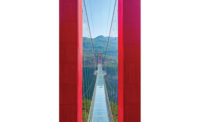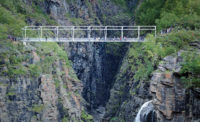 |
| Photo © Leonardo Finotti |
Loeb Capote Architecture and Urbanism
São Paulo
From Chicago to Copenhagen, movable bridges are an iconic feature of many cites. Now São Paulo has its own innovative rendition. Commissioned by Bayer to build a pavilion for showcasing its ecologically sensitive building products, São Paulo–based architect Roberto Loeb noticed that employees needed half an hour to walk from the metro station to his new structure, as well as to the offices and manufacturing facilities just across an adjacent canal. The steel bridge he devised, which also connects to an urban bicycle network, cuts that time to minutes and serves 9,000 locals and Bayer employees every day. The bridge's discs of greenery were inspired by the lily pads that float in the canal. “This was the beginning of the idea: two water lilies suspended on concrete pylons,” says Loeb. Beyond their beauty, the pads conceal electric motors that rotate the two halves of the span and allow boats to pass. Ultimately, says Loeb, the horizontal rotation makes for smoother and more efficient movement than that of a standard movable bridge that lifts upwards. The walkway itself demonstrates the design's emphasis on nature and functionality: metal grating allows for easy drainage and views to the water below, while a wood-surfaced pathway makes for a comfortable pedestrian crossing.




Post a comment to this article
Report Abusive Comment